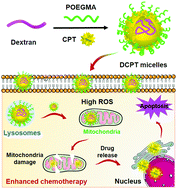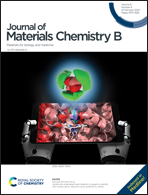Reactive oxygen species-activatable camptothecin polyprodrug based dextran enhances chemotherapy efficacy by damaging mitochondria†
Abstract
Low loading capacity, poor accumulation rate and weak permeability at tumor sites have been identified as the critical barriers for anti-cancer nanomedicines (ANMs). We herein reported a reactive oxygen species (ROS)-activatable ANM of dextran-b-P(CPTMA-co-OEGMA) (DCPT). It aimed to meet the above challenges for improving the therapeutic efficiency of chemotherapy. In this system, camptothecin (CPT) was selected as a chemotherapy drug and poly(ethylene glycol)methyl ether methacrylate (OEGMA) played the role of a hydrophilic block to enhance the water solubility of polyprodrug micelles. At high ROS levels in the tumor microenvironment, the micelles could be disassembled, and simultaneously, the anti-cancer drug of CPT would be released from the DCPT micelles. The 4T1-tumor growth would be greatly inhibited by these two DCPT polyprodrugs, with outstanding in vivo biosafety. The results of both in vitro and in vivo studies indicated the superior therapeutic effects of DCPT. The rational design of polyprodrug nanomedicines may serve as a promising strategy for the development of tumor microenvironment-responsive ANMs, thus improving chemotherapy efficacy.



 Please wait while we load your content...
Please wait while we load your content...